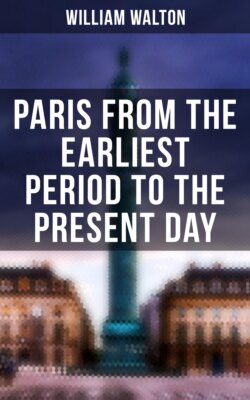Paris from the Earliest Period to the Present Day

Реклама. ООО «ЛитРес», ИНН: 7719571260.
Оглавление
William Walton. Paris from the Earliest Period to the Present Day
Paris from the Earliest Period to the Present Day
Table of Contents
Volume 1
Table of Contents
INTRODUCTION
INTRODUCTION
GALLO-ROMAN AND PRE-MEDIÆVAL. PERIODS. GALLO-ROMAN AND. PRE-MEDIÆVAL
THE COURT. AND THE UPPER CLASSES
THE COURT AND THE. UPPER CLASSES
THE BOURGEOIS. AND THE LOWER CLASSES
Volume 2
Table of Contents
THE ADMINISTRATION, NATIONAL AND MUNICIPAL
THE ADMINISTRATION, NATIONAL AND MUNICIPAL
Отрывок из книги
William Walton
Complete Edition
.....
This interesting excavation, but little known even to the Parisians, has now been transformed into a public garden, in the quarter between the Panthéon and the Jardin des Plantes, and is well worth visiting. The ancient Mont Lucotitius still heaves itself under the modern Parisian pavement, and the grades frequently become so steep that they have to be abandoned, and terraces and retaining-walls substituted. Although much less than a half of the oval of the original arena has been uncovered, the explorations have reduced the houses on the Rue Monge to but little more than tall façades. From under their rear walls emerge the amphitheatre and some of the curving rows of seats in stone, the latter much restored. In the walls of the arena are two rectangular, barred entrances, and one lower, arched one, from which we may imagine the gladiators or the wild beasts emerging. The floor of the arena is left in a roughly gravelled condition; at present, nothing more formidable is to be encountered there than three very little French boys making mud-pies in the puddle formed by last night's rain. A fourth, still smaller, is at some distance, absorbed in some dry engineering of his own at the foot of the old wall. Seated in the steep little green park which rises above the terraced seats, crowned with trees and shrubberies, and vocal with a prodigious twittering of birds, are three or four idle, bare-headed young women in "shirt-waists," one with a lover, and an old gentleman with a red ribbon reading his morning newspaper. The traveller can place himself on one of the benches in this pleasant little greenery, look down on the infantile engineers below, and make appropriate reflections.
A still more important architectural feature of the ancient city was the great aqueduct which supplied the baths of the palace on the river, its fountains and those of the populous quarter around it. The waters of three or four small streams to the south of the capital were united and conveyed in a channel, lined with cement, 19,100 mètres in length, which traversed the slopes of the hills on the eastern side of the Bièvre, and remains of which have been found at various points. To cross the valley and the stream, an aqueduct was constructed on arches at the locality which took the name of Arcueil, and where some of the masonry is still preserved in modern construction, "this aqueduct being some four hundred mètres long and fifty (?) high." It is computed that a supply of twenty-four cubic mètres of water was furnished every twenty-four hours. Remains of other and smaller aqueducts have been discovered at various points in the city. At Passy, surrounding the present Trocadéro, there were springs of mineral waters, which were conveyed to the city by terra-cotta pipes, passing along the banks of the Seine. In 1781, in the gardens of the Palais-Royal, were discovered the remains of great basins which are supposed to have been the piscines of the hygienic baths. Remains of Roman aqueducts have been found at various other localities in France, at Nîmes, at Lyons, at Metz, etc., and that over the Gard is still standing in part.
.....